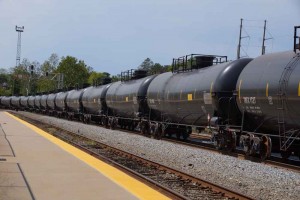Part Three, the Keystone XL Pipeline
When I was growing up in Fruita, Colorado in the 1950’s, the El Paso Natural Gas Company built a 26″ natural gas pipeline from north to south through Western Colorado. In flat country, laying a pipe is fairly straightforward. To lay a pipeline, dig, lay pipe, weld, wrap, and backfill. In the Colorado Plateau, the pipeline not only goes from point to point, it goes up and down.
North of Fruita, The line had to go over Douglas Pass. As Colorado passes go, it is no big deal. Not that high, but near the top there is steep and unstable ground famous for landslides. The trenchers, welding machines, side-boom tractors handling pipe, and bulldozers; all had to be winched up and down the mountainside. That is a slow, expensive process. To us in Fruita, it meant that our little town had lots of pipeliners for several weeks.
I mostly saw the pipeliners in Hill’s Cafe, where we often had dinner. The stereotype is that pipeliners are a wild bunch, but we didn’t see it in the cafe. They were quiet, well-behaved, some prayed before eating, and I liked them. After all, if you are from Bald Knob, Arkansas, how wild can you be?
That pipeline brings gas from Wyoming, Western Colorado, and Eastern Utah to markets in Texas and the southwest, including California. To my knowledge, it has few problems and quietly does its job. I think that pipeline has shaped my thinking about pipelines in general.
Today there is much oil and gas development in North Dakota and Alberta. A pipeline network exists to deliver crude oil from there to the refinery complex on the Gulf Coast. It can’t deliver all that is being produced. Proposed is a new line, the Keystone XL Pipeline that would run west of the existing line, picking up crude from the Williston Basin in North Dakota as well as the synthetic crude from the Alberta tar sands.
There is a lot of opposition for several reasons. One reason is fear of leaks. Big spills, contamination, fire, ground water contamination, and all the risks that go with moving lots of nasty stuff that burns. That Alberta synthetic crude is even nastier than regular crude. Its carbon footprint is much higher than oil from traditional sources. It is thick and has to be heated to separate it from the sand. Most of the crude oil refined here in Denver is tar sand oil.
The fact is that as long as demand for petroleum products stays high, that Alberta crude will go south, but in rail cars if the pipeline isn’t built. Here in Denver, there are many tank car trains headed south, competing with coal trains for right of way. In the upper Midwest there is so much oil traffic that farmers are having difficulty shipping their grain. Pipelines are safer than rail cars for shipping petroleum.
Some of the opposition is for environmental reasons. Tar sand crude is bad. Pipelines are bad. Fossil fuel is bad. All true. The solution is not stopping pipelines, but reducing demand. How to reduce demand? Make fossil fuels more expensive with higher taxes. Use the tax money to develop alternative energy and transportation. Build rails not freeways. Tell that to Republican legislators.
In the meantime, I think the pipeline is the best alternative until our energy policies change.


The big thing Republicans want is Jobs, but the number of jobs created will mostly be temporary at best, and the possibility of leaks remains for as long as the pipeline in in use! Better idea, build a refinery in North Dakota or Canada.
We have reduced out carbon footprint with the installation of a PV solar system on our garage and house roof. We have less than one month’s experience with it and today is a cloudy day. However, we are hopeful that our electric bill will be much reduced if not wiped out completely. We didn’t have enough unshaded roof room to get to 100% of our usage.
The cost of this system is offset by a 30% federal income tax credit, a rebate from Xcel for each kilowatt hour we produce and protection from future rate hikes. We have a $250 coupon from our installer, Namaste, for you if you think you might want to investigate and install solar on your house. Just let Bill know, and we can give or mail it to you.
I don’t even know how I ended up here, but I thought this post was good.
I don’t know who you are but definitely you’re going to a famous blogger if
you are not already 😉 Cheers!